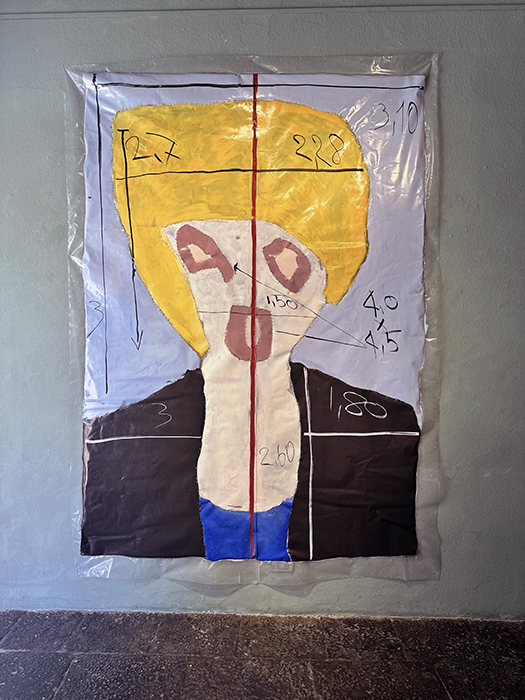SELECTED WORKS ARCHIVE BIOGRAPHY CONTACT INDEX
NEITHER YOU NOR I
"….Nell ambito della possibilita di rimetterre insieme le storie
…….Configurazioni possibili"
Il lavoro di Alessandro Di Giampietro nasce dall’osservazione dell’identità umana intesa come
insieme di stratificazioni che creano modelli comportamentali iconici nella società di oggi; esplora
i rituali umani, le pratiche intorno al corpo e i giochi che le persone mettono in scena per passare
da un archetipo a un altro. Ogni suo lavoro è un tentativo di ricostruire un evento in cui il confine
oscilla tra realtà e finzione, come quando gli esseri umani sono prigionieri dell’incantesimo del
comportamento sociale abituale. L’artista osserva l’essenza primordiale, avezza a camuffarsi, che
scatena la sua potenza quando chiede ai suoi modelli di giocare con maschere e oggetti di scena
e di rivelare la profondità del loro essere, svelandone i desideri più reconditi e i segreti taciuti.
Questo processo gli permette di collegarsi con l’energia intima che vede nei soggetti a cui scatta
una foto, sia nelle messe in scena che quando lavora con snap-shots spontanei. Il suo lavoro si
concentra principalmente su ritratti perché è affascinato dai negoziati inespressi che ogni essere
umano mette in atto con se stesso/stessa, al fine di esprimere l’assoluto. Questi rituali, per Di
Giampietro, indicano una magia istintiva che sottolinea l’unicità di ogni persona e che definiscono
il senso di individualità in generale. La mia pratica non ha un medium fisso ma spazia dalla
fotografia agli happening, installazione, video e danza intesa come liberazione inconscia del
movimento.


La mostra si sviluppa in due parti temporali distinte
Le opere selezionate per questa esposizione rappresentano l’occasione di rimettere insieme
diversi lavori che Alessandro Di Giampietro (Pescara,1972) ha eseguito negli ultimi quindici anni
tra Milano, Lisbona e Lubiana.
Il percorso parte da un nucleo di cento Polaroid scelte dai diversi progetti sviluppati tra il 2009 e il
2021. Goldenboy, 2009-2010, lavori presentati da Davide Di Maggio e documentati con due libri:
Roadside picnic Stromboli - Fiorucci art Trust - edito da Salerno editrice ; e l’edizione dei 20 anni
dello spazio Viafarini. Polaroid strappate e ricomposte che rappresentato i ritratti di persone del
mondo dell’arte, artisti, curatori. Overlapping, 2010-2011, documenta il censimento dei residenti
maggiorenni dell’ isola di Stromboli, Polaroid collages. Progetto supportato e prodotto da Fiorucci
Art Trust, in mostra per La prima edizione di “Volcano Extravaganza” 2011, curato da Milovan
Farronato. A vam Je Jasno, 2019, progetto\disco per la band post punk Balans, (Jump the
mummy). Trasformazione termodinamica priva di variazioni di energia interna. Protezioni
dagli agenti esterni, 2021. Serie di autoritratti in costume in ambienti non famigliari. Il lavoro
realizzato in un periodo di tempo transitorio, nel rientro in Italia dopo 5 anni passati tra la Slovenia
e il Portogallo, nel quale ero ospite in diversi luoghi. The Nowness of the Everyday portrait,
2022-2023, ritratti di maschera.

La fotografia è un medium espressivo dell’artista, un “fermo immagine” dove si intersecano
diverse discipline artistiche; da uno scatto di scena o di vita reale, di un video o di una
performance, come in costume o in maschera. Il volto, il corpo, i costumi, la maschera sono i
soggetti di una ricerca che indaga le identità possibili. Insieme alle polaroid due sculture dalla
serie Dove i sogni si accomodano. Maschere di scena, pezzi unici realizzati dall’artista e intese
come “opere aperte”.
Tra le opere realizzate appositamente per la mostra, Fosforo della serie Rivelate; cucite
dall’artista in chiffon colorati che attivano la trasparenza del tessuto attraverso la luce e il
movimento degli agenti atmosferici, come a dire che i mascheramenti dell’essere possano
ricondursi anche a quelli della natura.
Legati alla serie delle Rivelate, saranno presenti alcuni Bozzetti, studi preparatori in parte eseguiti
per il progetto The Nowness of the Everyday realizzato per Casa degli Artisti nel 2023. Sono
maschere disegnate con l’uso dello smartphone, stampate a laser su carta, frammentate e
ricucite con graffette in metallo. Impreziosite da un profilo in alluminio dorato, divengono veri e
propri lavori autonomi.
Due Masticate, di cui una commissionata appositamente dalla galleria; sono tra gli ultimi lavori
con il quale l’artista si sta cimentando. Pitture masticate su pvc, figure o meglio maschere
costituite nella loro essenza dalle stesse materie contraddittorie della società e dei costumi attuali.





Il secondo atto della mostra NEITHER YOU NOR I, si concentra sugli ultimi lavori
dell’artista, le Plastiche masticate.La galleria quindi,
dopo aver presentato un excursus quindicennale di opere realizzate
attraverso vari medium: fotografia, scultura, collage, tessuti, video; focalizza questa
nuova esposizione su un’opera di grande formato, cm. 286x200, Pupazza, in p.v.c,
pittura acrilica e graffette metalliche. Il soggetto deriva da una figura rappresentata in una
grande Rivelata, opera in chiffon colorati realizzata per Casa degli Artisti di Milano nel
2022. Questo soggetto origina in realtà da un happening immortalato in una Polaroid
(presente in mostra) del 2019. Di questi mascheramenti sono visibili anche due
Complementi d’arredo, maschere eseguite a Lubiana nel 2015.




Visibile in tre versioni, Pupazza incarna un alter ego (“un’altro io”) dell’artista, una figura
efeba, nel linguaggio corrente di oggi la parola è passata a indicare al contrario della
tradizione greca, un non-adulto, un ragazzo molto giovane, dalla bellezza delicata, quasi
femminea. Il taglio a mezzo busto ricorda quella di una foto tessera, formato utile al
documento che connota e fissa la nostra identità. Anche in questi casi, l’artista indaga
nell’identità umana intesa come insieme di stratificazioni che creano modelli
comportamentali iconici nella società di oggi. Ogni lavoro è un tentativo di ricostruire un
evento in cui il confine oscilla tra realtà e finzione, come quando gli esseri umani sono
prigionieri dell’incantesimo del comportamento sociale abituale. (LORENZO VATALARO)